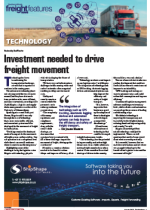More attention needs to be paid to the human element driving technological innovation and trends, according to specialist logistics technology and software development company Easy Clear.There is an increasing dependence on technology as the logistics industry experiences significant transformation through the integration of different technologies, including the Internet of Things (IoT), artificial intelligence, blockchain, autonomous vehicles, and aug mented rea lit y.“Naturally, there is a business need, challenge or innovation that requires a technological solution to enhance a current process, improve workf low or implement an entirely new and never-been-seen-before solution, but these need collaboration and communication between different parties to get it right,” explains sales manager Michael Henning. “While technology is at the forefront of our business, a unique understanding of the industry coupled with a deep understanding of our client’s business need enables us to find the right solution or build the right solution for the challenge. “This may require collaboration with the third party solution providers for a seamlessly integrated solution or partnering with other technological specialists to bring otherwise unknown solutions to the local market.”Both require input and understanding from all parties, including the party for which the solution is being sought, says Henning. “It is this relationship between partners, clients, suppliers, industry experts and innovators, complemented through and by the incubation of ideas in-house, that is critically important to the development of solutions and the improvement of services to the market that we serve.”According to Henning, the company’s vision of autonomous clearing is gaining traction, particularly within the e-commerce space, where data is more readily available from the moment the order is placed, enabling the automation of the RCG and clearance process, where the parties in the supply chain are technologically enabled and digitally connected.“Other new developments we are working on include solutions that will further improve the visibility of shipment data for clients, enabling the management and tracking of cargo reporting, making documentation far more readily available – all without the tedious task of collating and sending it. “Some of these are already available while others are soon to be launched via our mobile applications.”According to Henning, the Internet of Things (IoT) is making these technological innovations possible, and the ability to collect, collate and democratise data is far simpler.“Robotics and AI are impacting last-mile delivery and can already be seen in Europe in large warehouses and even on the streets of London delivering orders to one’s door. “The impact on the industry is both negative and positive,” he says. “There will be far fewer non-skilled labourers required to make that last-mile delivery or pack the warehouse, but equally more deliveries can be made, far quicker and at a lower cost for a greater return on investment.”He says the current trends being seen in the technology space are being driven by needs built up over five years. “As data improves and the accuracy improves so the processes can be enhanced to take advantage of these improvements. “Manual and repetitive processes can be replaced by automated and robotic artificial intelligence that can learn and adapt. “The constraints in the supply chain, often caused by inaccurate data, documentation and human intervention, can be streamlined to take advantage of this and speed up collection and delivery, minimise risk and improve the logistics supply chain.”

